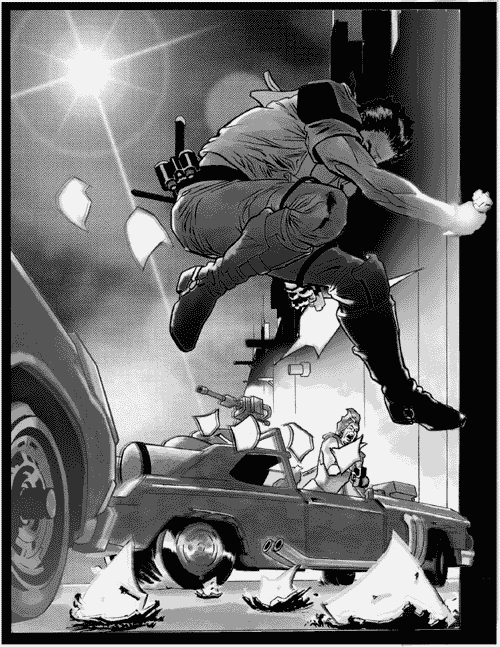Hypothetical Game Case Study: The Hood Ornament
| In the example game depicted here, set in a rough-and-tumble futuristic world, you play Kenneth Lassiter. America has dissolved into warring anarchy, with each man out for himself. What brought the country to its knees? It was the creation, in a secret government lab, of RK-36, a metal that acts like a mighty fuel a fuel that is never expended. It could have been used to help mankind, but instead it was funneled into a covert weapons project. When the man in charge of that weapons program went insane and tried to blackmail the government with the threat of using the weapon on a series of domestic targets, perhaps the country's leaders should have met his outrageous financial demands. They didn't believe he'd carry out his threats. In the conflagration, the country was all but destroyed, and so was all the RK-36…except one piece of the metal, which an artist fashioned into a hood ornament shaped like the head of Hermes.[6]
This ornament, when placed on the hood of a car and connected to the engine, powers that car to travel five times the speed of any other vehicle. In a land dominated by armed cars, this hood ornament has become the most sought after item in the land. Its energy can also be channeled into the guns on the owner's vehicle, making them significantly more powerful. Because of RK-36's both incredibly constructive and destructive properties, the hood ornament would provoke a feeling of both fear and cautious respect, much like nuclear power is viewed in our own world today. Fear and cautious respect are its first emotional associations. As everyone is scrambling for the hood ornament, it only falls into the hands of those tough enough to kill to get it. Over time it passes from one violent warlord to another. Thus, the ornament becomes a symbol of (becomes emotionally associated with) power. Later in the game, when a young man takes possession of it, his own family steals the ornament and hides it to protect him from the ruthless warlords who will surely come gunning for him. The family's plan backfires: The local warlord wipes them out and reclaims the ornament.
This family has helped you in the past, and you've come to care about them. When they're killed because of the ornament, it takes on another emotional association: tragedy. The young man was a member of the Book People. These people have a huge 18-wheel truck loaded with books the only books still remaining in the world. They need to escape to a safer part of the country, where they can open up a school and begin to teach. They're the repository of all civilization. Imagine if, earlier in the game, you were one of those selfishly jostling for power in this world. That is, let's say that the game encouraged you to do this. But one of your missions accidentally results in the death of two of the land's most knowledgeable teachers some of the only people capable of passing on knowledge. Consequently, many Book People are emotionally devastated. Some are friends who have helped you in the past by sharing with you critical pieces of information that help you survive information they know from books. Now you've got to undo the damage you did in accidentally getting two of their teachers/leaders killed. So, as seen in the illustration, you steal the ornament (taken by the warlord from that family he slaughtered) to put on the Book People's truck, so can speed the truck to safety. At this point, you've helped make up for the damage you did earlier. If the emotions evoked are real and the game's Emotioneering is done well, the ornament will take on the emotional association of redemption.[7]
When the Book People, in their truck with the ornament on the front, rocket through enemy lines to freedom, the ornament takes on the emotional association of hope. So, along the way, the hood ornament has picked up the emotional associations of:
Just like the handkerchief in Braveheart, the hood ornament becomes a Symbol that Takes on Increasing Emotional Associations. But, as befits a game, and as mentioned earlier, this would also be a Usable Symbol. |
EAN: 2147483647
Pages: 394
- An Emerging Strategy for E-Business IT Governance
- Assessing Business-IT Alignment Maturity
- Linking the IT Balanced Scorecard to the Business Objectives at a Major Canadian Financial Group
- Technical Issues Related to IT Governance Tactics: Product Metrics, Measurements and Process Control
- Governance in IT Outsourcing Partnerships
